We were lucky to catch up with Nia Coffer recently and have shared our conversation below.
Nia, thanks for taking the time to share your stories with us today Learning the craft is often a unique journey from every creative – we’d love to hear about your journey and if knowing what you know now, you would have done anything differently to speed up the learning process.
I went to SCAD, Savannah College of Art and Design, to learn about 3D art. I graduated from SCAD in 2022 with a degree in visual effects. In addition to SCAD, especially during the pandemic, I learned Blender by watching a ton of YouTube videos. That was definitely a huge part of my learning process especially when I was a beginning 3D artist.
If I had implemented more exercises focusing on traditional art principles like shape, line, and form earlier in my studies, I definitely would have been able to apply those techniques much more easily and therefore speed up my learning process in both 3D and traditional art.
Learning how to find reference and pick apart what I like about a piece of art has been essential for me. Everyone is inspired by something whether that’s a movie or a painting. But not everyone can identify why they are being inspired by that piece. Is it the color palette? Is it the camera angle of the shot? Is it the way the light is hitting the actor’s face? Is it the furniture design or the fabric choice? In my opinion, the answer can be all of those things and more but not everyone approaches it that way. Understanding how to analyze things you love and break it down can help you break down your own work and find your flow.
One of the biggest obstacles that stood in the way of me learning more was my own self-doubt. Having a loud negative inner voice debilitated me before I even attempted to do something. And if I’m being honest, I didn’t do a project or apply for a job because that voice was so loud in my head. It not only stopped me from learning more but also from going out and being social. My second biggest obstacle that got in the way of me learning more was not understanding how to prioritize my work. I still find it very difficult to prioritize my work. Everything will need my attention, but not all at the same time. It’s taken me years to find a system that my mind can follow and that can be adjusted for different times in my life.



Awesome – so before we get into the rest of our questions, can you briefly introduce yourself to our readers.
I got my start in the industry through my first internship in 2018. I interned at a visual effects company called Fuse FX in Los Angeles. I was a concept and digital matte painting intern. Fuse FX was my first exposure to the entertainment industry and I had the most amazing time with the entire Los Angeles office. They actively showed what a positive and collaborative environment looks like, even under stressful deadlines.
Four years later, I landed my first professional job as an artist in the industry. I became a CG Generalist at Nickelodeon Animation in 2022. I was brought on to an unannounced show and was working primarily remotely. Even though I was far away from the office, every person on the team was so welcoming. We were having the best time and working hard to create an impactful show. I hope it comes out soon and so everyone else can enjoy it. It is a show that you know had a lot of love poured into it.
As a professional artist, I have mainly been a CG Generalist. This means that I am a 3D artist that has a wide-variety of disciplines. One of my favorite roles I have done was as a camera animator. I have also worked as a digital matte painter and a texture artist on short films. So my skills professionally really do vary depending on the project. Eventually, I’d like to focus on 3D layout and previsualization.
I also work as a freelance artist. I have created posters and illustrations for some local events and businesses. However, most recently I have been commissioned to create 3D characters. Creating characters is extremely very daunting to do but I find those commissioned pieces to be very fulfilling.
My brain processes art through the things I grew up with. I mostly grew up as a DVD kid who watched the credits of every movie and then would play bonus features right after the last credit rolled. I also didn’t grow up drawing and painting as much as other kids. I danced starting at the age of three in five different dance styles. Dancing was my gateway into the world of art, from movement to costume design and even stage lighting.
These aspects of my childhood allow me to approach some areas of art differently. For example, when I have to block out a large-scale fighting sequence, I think about ballet. I approach it similarly to how a choreographer orchestrates a group of dancers. During rehearsals, the choreographer sits in different areas of the auditorium to not only analyze your dance moves but the formations and the timing of each piece. Adjustments are made starting with formations and ending with details like pointed toes. So, with an intense background in dance, I can translate that mindset to creating an impactful fighting sequence.
To get a better grasp of that idea, maybe I should give an example. When I start a fighting sequence, I think about what kind of space the action is taking place in. If the environment is a large space, I can play with some ultrawide crane shots versus if the space is small I need to create an intimate feel with my camera angles. This is similar to getting to know your performance space. It’s important to be aware of spots that may block your view and affect your spacing. Next, I do rough blockouts of camera positions as I play with simple fighting formations. I typically work to find cameras for the first shot, the middle shot, and the final shot. I place the wide cameras first then graduate to medium shots, leaving closeups last. I compare this to setting up the main accents in a ballet. The beginning when the curtain comes up, the middle at the crescendo of a movement, and the ending when you leave the audience with a lingering feeling. When the initial cameras have been placed then I go ahead and work to make rough animations for the characters. This can range from just rotating the characters, and props if they have any, to rigging them and doing a first pass animation on them. In dance rehearsals, dancers “mark” their moves before going full out. These first pass animations and rotations are similar to that idea. The goal is to have nice foundational cameras and rough animations so that a blueprint is created and used as a jumping off point for feedback and eventually a finished piece.
I’m very proud that I haven’t given up on being an artist. I love creating but the process isn’t always easy, especially when life and the real world events happen. How I create and what I create changes and I’m personally ok with that. As long as I keep creating and learning new ways to do art then I feel like I’ll always be proud.
I became an artist because I watched movies and experienced museum exhibits that brought out strong emotions in me. I create art that can be traced back to those emotions I had as a kid. Those that follow my work can experience those emotions through the art I share.
Are there any resources you wish you knew about earlier in your creative journey?
There are 5 resources I’d like to share. All of these resources have had a tremendous impact on me as an artist.
1. PurRef: PurRef is a free program where you can keep track of all your images. I typically use it to organize and hold my reference images for projects. Whether you’re one that needs a place to organize their thoughts or to just have a common place to make a moodboard, PurRef is for you. One of the best perks of this free program is that the size of your PurRef board is completely adjustable to your screen workspace and keeps the resolution of your image exactly the same as when you uploaded it. It’s a staple for me.
2. Scott Eaton’s Bodies in Motion: This website is a must for any artist that has been looking for reliable, dynamic human photography. It’s been a game changer when practicing gesture drawings and even while doing 3D anatomy studies. This library of content will take your studies to the next level of understanding how the human body moves and functions.
3. Access:VFX – Access:VFX is a fantastic non-profit organization that provided the best advice and helped me set me up to have a successful artistic career. To quote them directly, Access:VFX “focuses on actively pursuing and encouraging inclusion, diversity, awareness and opportunity under its four pillars of Inspiration, Education, Mentoring and Recruitment.” This organization gave me the mental awareness I needed to pursue an art career. I also learned the importance of being a growing artist. The way to grow is to learn. Learning a process, not an image. An artist should always be learning and growing. How fast you grow doesn’t matter as long as you’re growing.One step at a time.
4. Women in Animation (WIA): Women in Animation, also known as WIA, is a “non-profit advocacy group supporting female-identifying and non-binary people in animation, visual effects, and gaming…” I have participated in WIA’s mentorship circle program twice. In each mentorship circle I have participated in, my idea of what kind of artist I could be shifted. I started networking and building strong professional relationships through WIA. My mentors and I continue to keep in contact months and years after our mentorships. I have also made close-friends from each mentor group that I’m still in contact with and have even worked with professionally. WIA also provides scholarships, one of which I received in 2020. That scholarship opened a new door to artistic careers I never would’ve imagined without that particular opportunity.
5. Thriftbooks: I learned from a mentor during my time at Fuse FX that art books are one of the most valuable sources of reference and inspiration you could have. I have since become an art book collector but I’ve done it on a budget through thrifting. Thriftbooks is my go to website for used art books. A good amount of my art book collection has come from them. I’ve also come across books that are out of print at such a low price because others don’t understand the value of it. Whether you’re looking for art books or just books to add to your reading list, I recommend Thriftbooks.




How did you build your audience on social media?
In all honesty, I’m still building an audience on social media. I mainly use LinkedIn and Instagram, however I use them differently.
LinkedIn is a professional industry platform. Many people, myself included, network on the app and view job postings to find work. With that said, as a new and young artist, I needed to approach my profile on LinkedIn differently. I needed to build an audience from the ground up and the audience I wanted were recruiters and artists at the top of their field. I didn’t just want followers. I wanted connections. So, I posted what I had, which back then were illustrations I was doing in my AP Art class in high school. I tested out different approaches and some worked better than others. As I grew in my craft, my art got better and I found my voice when posting about my work. What broke the flood gates open for me was that I started posting the art and works in progress I wanted recruiters to see. Once I did that, I got inquiries on my approach to a project and things flew from there. I post on LinkedIn every couple months. This is because most of my professional projects are under NDA and my well-seasoned personal projects take more time to prepare for a professional platform like LinkedIn.
As I stated before, Linkedin being a more professional platform, I don’t post all my work there. So that’s where Instagram comes in. Instagram is my public online art journal. My approach of posting what I wanted to share extended there and expanded into some of my other interests, including drawing and painting. I also share art from artists that inspire me, and not all of them are 3D artists. They include fashion designers, traditional sculptors, athletes, and so many more. My Instagram is a more open door into who I am as a person paired with the art I do as an artist. I do keep my posts on Instagram more relaxed with two posts a month. I always want to post quality pieces instead of spamming followers with art I don’t like. What I like about Instagram is that I share one 3D piece and one 2D piece per month. Some are from the archives of when I was starting out as an artist and others are new pieces or works in progress. I like splitting it up between the two because I get to practice more of my artistic talents this way. I’m not boxed into one or the other.
Contact Info:
- Website: https://niacoffer.com/
- Instagram: https://www.instagram.com/nia.coffer/
- Linkedin: https://www.linkedin.com/in/nia-c-055765122/


